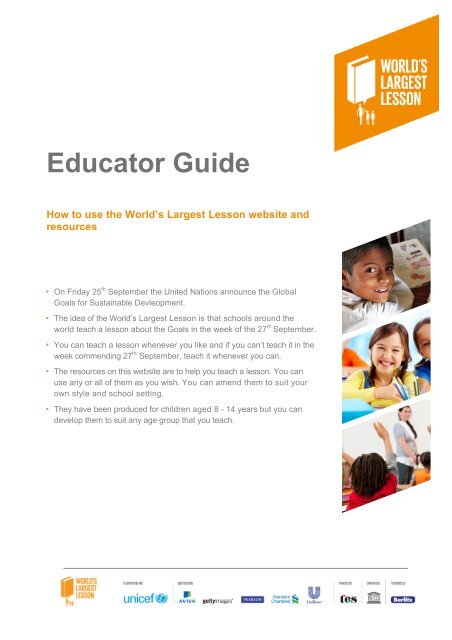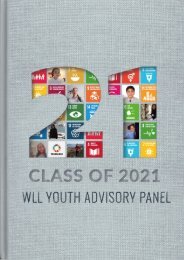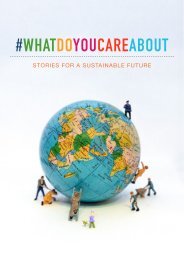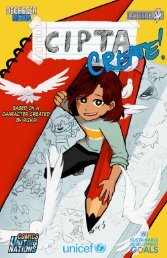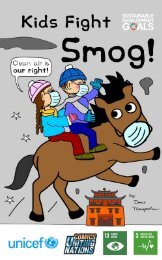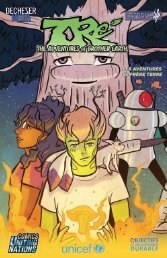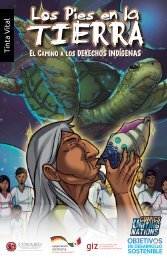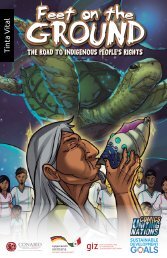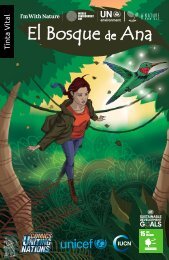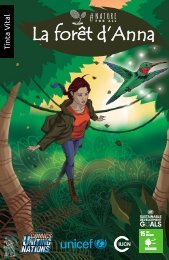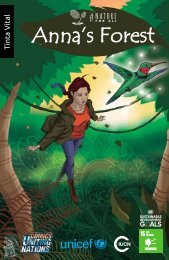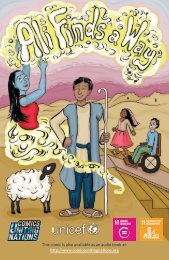The World's Largest Lesson Teacher Guide
A step by step guide to the resources for teachers available for the World's Largest Lesson
A step by step guide to the resources for teachers available for the World's Largest Lesson
Create successful ePaper yourself
Turn your PDF publications into a flip-book with our unique Google optimized e-Paper software.
Educator <strong>Guide</strong><br />
How to use the World’s <strong>Largest</strong> <strong>Lesson</strong> website and<br />
resources<br />
• On Friday 25 th September the United Nations announce the Global<br />
Goals for Sustainable Devleopment.<br />
• <strong>The</strong> idea of the World’s <strong>Largest</strong> <strong>Lesson</strong> is that schools around the<br />
world teach a lesson about the Goals in the week of the 27 th September.<br />
• You can teach a lesson whenever you like and if you can’t teach it in the<br />
week commending 27 th September, teach it whenever you can.<br />
• <strong>The</strong> resources on this website are to help you teach a lesson. You can<br />
use any or all of them as you wish. You can amend them to suit your<br />
own style and school setting.<br />
• <strong>The</strong>y have been produced for children aged 8 - 14 years but you can<br />
develop them to suit any age group that you teach.
Please Note<br />
Global Citizenship Teaching And Sensitive Subject<br />
Areas<br />
• <strong>The</strong> discussions you have with your students in many of these lessons<br />
need to be handled sensitively and with consideration given to students’<br />
backgrounds and experiences. You want to make the classroom a ‘safe’<br />
place for your students to share their ideas and even experiences.<br />
Some students may want to be excused from certain discussions and<br />
this should be respected. You may find the following sources of advice<br />
on how to approach controversial topics in the classrooms useful.<br />
• Oxfam UK’s guide to Teaching Controversial Issues<br />
o http://www.oxfam.org.uk/education/teacher-support/tools-andguides/controversial-issues<br />
• <strong>The</strong> Historical Association’s guide to Teaching Emotive and<br />
Controversial History<br />
o<br />
http:// globaldimension.org.uk/resources/item/1522<br />
• Many teachers find the Philosophy for Children techniques useful when<br />
handling discussions of this nature, you can read more here<br />
o http://globaldimension.org.uk/news/item/13650
'<strong>The</strong> <strong>World's</strong><br />
<strong>Largest</strong> <strong>Lesson</strong>'<br />
A Film<br />
How to use in the classroom<br />
• This 6 minute film introduces the Global Goals to children. It establishes<br />
a context for the Goals, explains the role of the United Nations and asks<br />
children to think about how they can help contribute to the success of<br />
the Goals. It suggests that as human beings we all the most creative<br />
creatures that live on the earth and that we all have the power to make<br />
change.<br />
• You can use this film as part of an assembly, class or lesson to<br />
introduce the Global Goals; using either of the introductory lesson plans<br />
(30 or 60 minutes).<br />
• You can show this film as the “jumping off” point for any lesson on the<br />
Global Goals. Show it at the start of the lesson to establish a context for<br />
learning.<br />
• You could also use this film as the lesson itself by stopping it at<br />
appropriate moments to discuss what children have seen and heard.<br />
You can check for understanding and highlight issues that you think are<br />
particularly relevant to them and ask them to think more about them as<br />
they are watching.
'Heroes for Change'<br />
– A Comic<br />
How to use in the classroom<br />
• This 6 page comic book introduces the Global Goals to children . It<br />
establishes that we all have a superpower – the ability to imagine a<br />
better world and to create it.<br />
• It invites children to become superheroes for change and help make the<br />
Goals a success.<br />
• You can use the comic to replace or support the film in an assembly,<br />
class or lesson and introduce the Global Goals; using either of the<br />
introductory lesson plans (30 and 60 minutes).<br />
• You can share the comic with students to read after a lesson.<br />
• You can use the comic as the lesson itself, by printing and sharing it or<br />
displaying it at the front of the class, and reading through it together.<br />
You can stop to check for understanding, ask questions or start a<br />
discussion about the images and text that you think are most relevant to<br />
the children you are teaching. <strong>The</strong> images are rich with meaning and<br />
can stimulate thoughtful discussion.
'A World We Want'<br />
– the Global Goals<br />
Explained<br />
How to use in the classroom<br />
• This book has been written, with contributions from young people<br />
themselves, to explain the Global Goals in more detail. It contains a<br />
glossary of terms at the front and makes a connection between the<br />
Millenium Development Goals and the Global Goals for Sustainable<br />
Development at the back. It describes each goal in turn and describes<br />
what it will take to achieve it. At the end of each page there is a question<br />
for children to consider.<br />
• You can use this book to support all learning about the Global Goals. It<br />
can provide teachers with simple and valuable background, and children<br />
and young people with the detail that they might need to understand<br />
each goal in turn.<br />
• You can print and share it with your students or read through sections<br />
together if discussing any specific goal.
<strong>Lesson</strong> Plans<br />
This collection of lesson plans has been created by<br />
teachers for teachers.<br />
<strong>The</strong>re are two types of lesson plan. <strong>The</strong>y link to goals<br />
and also to curriculum areas.<br />
Group 1<br />
Introducing the Global Goals, the principles behind the<br />
Goals and actions we can take.<br />
<strong>Lesson</strong> Plan Title<br />
• Introducing the Global Goals 30 minutes (Citizenship)<br />
• Introducing the Global Goals 60 minutes (Citizenship)<br />
• Working Together to Achieve the Goals (Citizenship)<br />
• Understanding Sustainable Living (Geography and Social Studies)<br />
• No Point Going Halfway – From MDG’s to the Global Goals (Geography<br />
and Social Studies)<br />
• <strong>The</strong> World Is Not Equal – Is That Fair? (Citizenship)<br />
• Design for Change: One Idea: One Week (Citizenship)<br />
<strong>Lesson</strong> plans created in collaboration with Think Global www.think-global.org.uk. Promoting learning for a just and<br />
sustainable world.
Group 2<br />
<strong>Lesson</strong> plans linked to specific goals and curriculum<br />
areas.<br />
Goal<br />
<strong>Lesson</strong> Plan Title<br />
Global Poverty – Local Solutions (Geography and Social Studies)<br />
A Healthy Start (Citizenship, Health Education)<br />
• Education Transforms Lives (Language Arts, Geography and Social Studies)<br />
• Everybody Wins When Girls Can Stay In School (Geography and Social Studies)<br />
• Millions Of Children Are Still Not In School – What Can Be Done?<br />
(Citizenship, Geography and Social Studies)<br />
Mission: Gender Equality (Citizenship, Geography and Social Studies)<br />
Clean Water For All (Science, Geography and Social Studies)<br />
Energy and the Global Goals (Science, Geography and Social Studies)<br />
<strong>The</strong> World Is Not Equal - Is That Fair? (Citizenship,Social Studies)<br />
• Understanding Sustainable Living (Geography and Social Studies)<br />
• An Energy Consumption Project (Maths, Science, Geography and Social Studies)<br />
Protect Our Marine World (Science, Geography and Social Studies)<br />
<strong>The</strong> impact of pollution on our planet (Science, Geography and Social Studies)<br />
• Understanding Community Violence (Citizenship)<br />
• <strong>The</strong> Power of Peace (Social Studies, History)<br />
• Working Together to Achieve the Goals (Citizenship)
Encouraging Action<br />
For <strong>The</strong> Global Goals<br />
• As educators, advocates and campaigners you have the power to inform<br />
and empower children and young people, so they are able to take action<br />
to help end poverty, reduce inequality and fight climate change.<br />
• Here are some ways to encourage children and young people to take<br />
action:.<br />
• Children aged 8-14 can find their “I Can” Superpower with your help!<br />
• Download our Design for Change lesson plan ('One Idea : One Week')<br />
and help children create change in their community now. <strong>The</strong> lesson<br />
plan and all the resources at www.dfcworld.com take children through a<br />
framework for thinking - Feel - Imagine - Do -Share (FIDS). This can be<br />
used to all settings and with children of all ages.<br />
• Young people can also join existing youth organisations and networks<br />
who are working together to advocate for change, and to hold their<br />
government to account for the commitments they have made by signing<br />
up to the Global Goals. <strong>The</strong>se organisations include:<br />
o www.plan-international.org,<br />
o www.wagggs.org/en/home<br />
o www.restlessdevelopment.org<br />
• You can download a toolkit for children and young people who want to<br />
make sure their voice is heard in a post-2015 world. <strong>The</strong> toolkit will help<br />
them develop the advocacy and campaign actions that they themselves<br />
want to take.<br />
o www.restlessdevelopment.org/file/global-agreements-grassrootsadvocacy-toolkit-pdf


